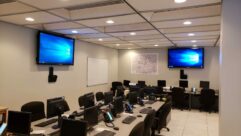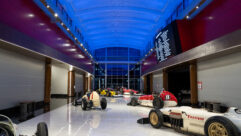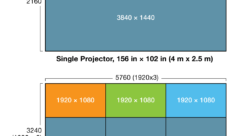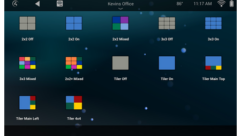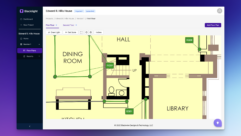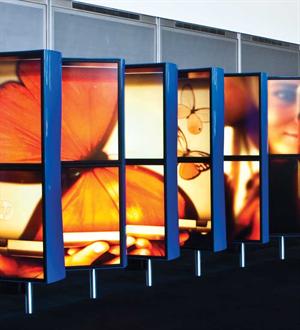

Not Just a Videowall
These days it’s amazing what creative AV designers and integrators can make out of display technology. With the right software, content, and planning, videowalls become works of art.
Sometimes clients ask for the darnedest things. When it came time to reimagine the lobby at Hewlett-Packard headquarters in Palo Alto, Calif., interactive software developer and video installation specialist Three Byte Intermedia was tasked with delivering a unique videowall solution — one that had to look as good facing backward as it did forward.
“They wanted an interesting, forward-thinking installation that could showcase their technology,” says Olaaf Rossi, co-principal at New Yorkbased Three Byte. “Still, this was a little different. We’re always being asked for large video displays running native resolution content because designers want as good-looking an image as possible. Fortunately, now we can render things that five years ago were much harder to do.”
HP and its design consultant, Tronic Studio, wanted a videowall (built with HP equipment) that would greet executives and customers when they entered the building, but could also be turned around to show video and messages as people exited the building’s auditorium, which is located in back of the lobby. The solution was a videowall made of 36 screens attached to 18 columns, divided into two groups with a pathway to the auditorium in between. It was an innovative design, but one with a problem.
“If you spin the monitors 180 degrees so they’re facing the opposite way, but you keep the same video content, your columns of video will be oriented correctly top-to-bottom, but each slice will be out of order,” says Three Byte co-principal Chris Keitel. “The video that needs to be in the leftmost position will be on the right.”
Welcome to the wonderful world of modern videowalls. Your clients, whether they’re retailers, corporations, or even government agencies, are enamored of big, beautiful video for communicating their messages or viewing information. They don’t always understand how you’ll give it to themor whether you even canbut they know they want it in their store windows, lobbies, and public spaces. They want it in high-definition and, as usual, they want it within budget. As a result, videowalls have evolved from glorified displays to works of technological art.
“There’s always going to be a solution, it’s just a matter of managing the client’s expectations,” says Joseph Fusaro, project manager for McCann Systems of Edison, N.J. “We’re actually not artists, but if people come to us with a concept or a bright idea, we’ll figure out the technology to make it happen.”
Not Just a Videowall
These days it’s amazing what creative AV designers and integrators can make out of display technology. With the right software, content, and planning, videowalls become works of art.
These days, the technology for creating videowalls runs the gamut from thin-bezel flat-panel LCD screens to modular LED projection tiles, traditional cubes and rear-projection screens to new laser phosphor display solutions. There are a host of video switchers, scalers, and processors that ensure the correct content goes to the correct part of the videowall at the correct time.
THE SOFTER SIDE OF VIDEOWALLS
McCann Systems used Christie MicroTiles for a pair of 3×10 videowalls the company rented to Versace during Fashion Week in New York. The tall, vertically aligned walls required a custom mounting solution, as well as custom fa§ades to surround the screens.
Mechdyne Corp., which has made a reputation out of building large, multiwindow projection walls for command and control, engineering, and other visualization applications, sees information overload as a primary driver of the projects it works on. “Our typical customer has one or two applications that could take up the entire display wall,” says Kurt Hoffmeister, MechDyne’s vice president of research and development. “But in terms of windows, there might be videoconferencing, data from a variety of sources, and smaller applications that might not be as graphics-intensive.” Getting all that on a single wall can require a lot of pixels.
Mechdyne did a 37-by-13-foot wall for the U.S. military’s Joint Intelligence Laboratory in Norfolk, Va., that uses eight Sony SXRD projectors to generate 53 million pixels. Two of the 4K projectors are installed as a stereoscopic pair, which means part of the massive videowall is in 3D. “Just the 2D part is 24 channels of HD resolution,” Hoffmeister says.
Unlike most traditional AV systems, the modern videowall is as much about the software that runs it and the content it displays as it is about the part of the system everybody seesthe display.
“You don’t typically just take an HD feed and plug it into a videowall,” McCann’s Fusaro says. “It’s not going to look good.”
For HP’s headquarters, Three Byte developed custom software to run the rotating videowall. The company’s principals once worked for integrators Electrosonic and Scharff Weisberg, so they had extensive experience with show controls and video installations. They considered using Dataton’s Watchout show control software to drive the wall, but because of the wall’s unique design, they discovered something unusual. “This was a weird situation where we said we could write custom software for less than an off-the-shelf solution,” Rossi says.
Part of this decision was driven by contraints put on Three Byte by the site itself. Out of the box, Watchout would have required 36 computers to run HP’s 36-monitor videowall, according to Keitel, but the back-end system could only include nine PCs, in part because the equipment room was no bigger than a single AV rack.
THE CASE FOR PRECISE CALIBRATION
Credit:
While some videowall technologies have come a long way in minimizing the need for manual calibration, others, such as display cubes or projectors, still require an integrator’s attention to ensure the best picture. A videowall is supposed to attract and awe viewers. But if the displays within a wall aren’t accurately and identically calibrated, distracted viewers may reject the message.
Many factorsdynamic light range, gamma, white balance, color saturation, hue and tint, and edge enhancementcontribute to the way a picture is displayed, and all of them can be adjusted to some extent. Furthermore, no two videowalls’ individual componentsor monitors that come off the same assembly lineprovide identical pictures or age the same way. Multiply the number of displays or cubes in a wall by all of these factors and you can see how complicated it is to maintain consistent calibration among displays or cubes in a videowall.
Companies offer precision display calibration systems, but it’s always surprising the number of installers who attempt calibration the old-fashioned way: eyeballs only. Even the most visually acute person is incapable of distinguishing incremental variations of light at high levels (above 50 foot-lamberts) and color deviations. That’s why an integrator needs technical help from computerized equipment and light sensors that are designed specifically for video calibration.
Recognizing the increasing popularity of videowalls, many display manufacturers have built in automated systems with self-contained sensors and software to make adjustments. Some perform adjustments on individual cubes, while others use a common controller that sends commands via a communication link to all the displays. In both cases, these automated systems are useful, but limited in their capability. Their built-in sensors are subject to drift, resulting in inaccuracies. Also, as the light engines inside the systems age, their high-level range typically diminishes to the point where it cannot respond accurately to commands from the recalibration system.
In fact, it’s normal for even a new display to change significantly in picture performance during its initial hours of operation. Recognizing this, most manufacturers recommend that a video system be professionally calibrated after a burn-in period of about 100 hours.
The Old-Fashioned Way
If built-in, automated calibration is limited, how do you achieve the ultimate goala uniform, eye-pleasing videowall? Enter the skilled AV integrator who, with the aid of professional tools, can measure foot-lamberts, plot gamma responses, and analyze light output characteristics to derive the best picture. While what happens during calibration is complicated, the instruments do the bulk of the heavy lifting. And with the appropriate software, precise calibration is greatly simplified. For instance, most technicians use a laptop computer equipped with specialized software to control a luminance and color meter, which provides more precise display calibration.
Exactly how calibration is accomplished on a given videowall depends on the manufacturer. In some cases, the integrator will have to make individual measurements for each display cube. Alternatively, he or she will apply calibration techniques via the main processor and send commands to all displays through the overall control processor.
While the exact methodology varies, the calibration process is essentially the same. After using auto set-up to the extent possible, the integrator sets up dynamic light output range in each display, addresses gamma, looks for white balance and grayscale tracking, makes color adjustment, assesses hue and tint, and then, finally, compares sharpness.
Whether it’s a videowall or your home TV set, optimal calibration has a beneficial byproduct: It reduces energy consumption by as much as 30 percent. Less electricity means less internal heat and associated component stress, with the potential of extending the display’s life by as much as 50 percent.
Tempting as it is to rely entirely on an automated system for calibration, the most successful integrators do more. Automation is limited, and its effectiveness must be both double-checked at the time of installation and reassessed periodically by an integrator to ensure optimum quality. Otherwise the visual results will not only be disappointing but will result in lost revenue or lost customers.
Glen Kropuenske is an application engineer at Sencore.
— Glen Kropuenske
Moreover, Three Byte wasn’t sure off-the-shelf software could handle the video mapping that was necessary to address HP’s and Tronic’s vision for the wall. “Being able to spin the monitors around and have that taken into account by the video would have been very difficult with Watchout,” Rossi says.
The finished system, dubbed HP Manifold, can decode eight simultaneous 1080p, 30-frames-per-second MPEG-2 files per computer and render 74 megapixels across a videowall whose resolution is 32,498×3972, after taking into account mullions and other spacing between the screens. And Three Byte also wrote a custom content management system tailored to the HP lobby space with a previsualization mode that allows the client to see how the video will look before it runs. “The CMS allows a user to stretch and position videos on the wall, specify transparent overlay and underlay images, and build synchronous playlists for multiple videos running on different parts of the wall,” Rossi says.
Some sacrifices had to be made in the installation. The HP LD4700 47-inch LCD monitors don’t exactly have thin bezels, which in recent years has become a key feature of flat-panel displays used in videowall installations. Between dropping panel prices, ever-thinner bezels, and innovative mounting solutions, LCDs have become an attractive solution for larger, more cost-effective videowall installations. But at HP, even if the preferred displays did have narrow bezels, it wouldn’t have a made a big difference in the look of the finished videowall.
Because the ability to rotate the displays was central to the designer’s vision, the backs of the columns couldn’t be an eyesore. They were therefore fabricated with a sculptural fiberglass shell on the back that would catch the eye even if the screens were turned to face the auditorium. When everything was attached to the poles and the poles installed in the floor, the AV team had to ensure that each pair of monitors with their sculpted shells could still spin freely. “Even if the monitor had no bezel, there had to be a physical gap in order for the monitors to turn,” Keitel says.
For now, the monitors must be rotated by hand. A plan to motorize the system so the panels in the wall could turn programmatically was dropped from the initial budget but is tentatively scheduled for a second project phase in 2011. Three Byte continues to monitor the videowall to ensure its installation decisions are holding up. For instance, the firm had to route high-resolution cables from the equipment room, under the floor, and up through poles to the displays, which would turn throughout the day, “Now you’ve got physical issues because the cable needs to rotate and the power has to be done right so you’re not breaking connectors and losing your video signal all the time,” Keitel says.
Three Byte ran 200-foot fiber-optic DVI cables from the equipment room to a trench that runs behind the monitors (the trench also houses nine Tannoy speakers and three subwoofers to provide audio). “The cables are then panelized and there are small HDMI cables that run up the columns and into the monitors,” Rossi explains. “So if we ever do break an HDMI cable, which we haven’t so far, we don’t destroy the very expensive fiber cable that’s running back to the control room.”
Also, there’s no switching system. Everything is handled in software. Motion sensors detect a visitor in the lobby and can trigger specific content, much of which is tailored to the HP Manifold. “Only a custom solution could meet the needs of this installation,” Keitel says.
Not Just a Videowall
These days it’s amazing what creative AV designers and integrators can make out of display technology. With the right software, content, and planning, videowalls become works of art.
When it comes to the content playing on a video-wall, “custom” should always be the word of the day, designers and integrators explain. Because today’s videowalls come in all shapes and sizes, making them look good often requires content written for its aspect ratio and resolution. Traditional HD video won’t always yield the best results.
THE CONTENT PUZZLE
The New York City Visitors Center at Tavern on the Green boasts one of the first videowalls to incorporate Sony Ziris Canvas software for mapping and scheduling video content. The curved wall has 15 displays, each served by its own Sony PlayStation.
“[Full HD is] only 1080p and the resolution of these video-walls is often much higher,” says McCann’s Fusaro. “So you have to make sure you get the content and graphics people involved as well. We show them demos of what happens when you feed in just an HD signal and they say, ‘Wow, that doesn’t look good.’ When you show them custom content designed for the native resolution of a videowall, they think it looks great.”
When McCann Systems provided in-store video-walls to fashion designer Versace during New York City’s Fashion Week in September, the company invited the client into its facility to see a full mock-up, running Versace’s video content, so the client knew what to expect from the finished product. “It made the installation easier on-site because we did the demo here,” Fusaro says.
Glenn Polly, owner of New Yorkbased Video-Sonic Systems, says his company has seen a lot of interest in videowalls from clients, but they aren’t always well versed in content requirements either.
One upscale, Paris-based retail client has a harder time matching content to videowall than others. “It takes them about three or four tries on each new installation to get the right video in the store,” he says. “They’ll send us content for a 2×2 wall but it will be landscape instead of portrait, or they’ll send us content for a 2×2 that they produce for a 3×3 and that images will fit the height but won’t make the width. There a lot of adjustments you can make to re-shape an imageadd height and width, stretch it. But you don’t want to do any of that. You want the picture to be produced pixel-for-pixel.”
For McCann’s Versace videowalls, running pixel-for-pixel wasn’t necessarily the best option. The client only intended to rent the videowalls for a week. Still, Versace had developed vertically aligned content that would work for the walls McCann designed. And the technology that the integrator chose had built-in intelligence to maximize the visual impact.
“We went with Christie MicroTiles,” Fusaro says. “They’re versatile because they’re smaller cubes and you can arrange them in different geometric patterns. Every client is going to want a different pattern and this makes it easier to do. They also have a very tight resolution (720×540 per tile and a 0.6-millimeter pixel pitch) plus the system has the ability to scale the image well. With some flat-panels, the resolution runs away on you. Some can scale but they’re not very good at it, then you have to put a scaler behind the wall and you’re adding more product, more complexity, more points of failure, and more expense.”
McCann built a pair of 3×10 HD videowalls, for Versace’s storefront windows on Fifth Avenue. “[The tiles] stack on top of each other, then you build some apparatus behind it to keep the wall from tipping,” Fusaro explains. “In this installation we braced it to the ground and all the way up to the ceiling, then out to the side with wings, which were disguised by a façade that was designed around the tiles. So it was easy and relatively inexpensive to build the rigging mechanism.”
There’s a high-resolution PC behind each wall, feeding the content into a Christie external control unit. The controller maps out all the tiles and deter-mines the best resolution to run them. Then it makes brightness, contrast, and color adjustments. The tiles themselves can communicate with each other in order to autocalibrate the entire wall.
Fortunately, McCann has found MicroTiles easy to service. “Right after we were done with the installMurphy’s Lawwe had one tile go bad and it was at the bottom of the stack,” Fusaro says. “But because of the way the MicroTiles are put together, we just popped off the front cover, pulled the engine out of it, put in a new engine, and within 15 minutes that part of it was done. In five more minutes, the system calibrated itself and we had a nice even palette again. It was interesting to watch happen. You saw the wall changing before your eyes.”
Not Just a Videowall
These days it’s amazing what creative AV designers and integrators can make out of display technology. With the right software, content, and planning, videowalls become works of art.
SITE SEEING
Fusaro emphasizes that with any videowall installation, you need to pay particular attention to the site itself. Clients who say they want video in a certain location may not understand whether the location is ideally constructed to handle the videowall they envision. At Las Vegas’ McCarran International Airport, where installers are erecting an enormous 33-by-19-foot videowall of Samsung LCDs in its new D concourse, it was discovered early on that the concourse’s architects hadn’t planned enough support for such a massive display. Premier Mount has been working on the project to supply custom mounts that will support the wall, enable adequate airflow, and ensure the displays are serviceable. Vision Sign, which specializes in such installations, designed the structural framework for the walls and fabricated the necessary components.
NOW PLAYING ON PRO AV TV
Credit:
At InfoComm 2010, Prysm launched a new videowall technology called laser-phosphor display (LPD). LPD technology uses a laser engine to excite phosphors on a surface-emissive screen, causing them to emit red, green, and blue, and produce a high-resolution image. The lasers modulate at a 240-Hz refresh rate to eliminate motion blur and the individual display modules create just about the thinnest bezels possible today. To reduce the gap between modules, Prysm developed EdgeBoost, which increases the brightness of the pixels nearest to the panel’s edge, making it appear almost seamless, with a bezel that’s just 0.25 millimeter wide.
Last month, American Eagle Outfitters’ new outlet in New York’s SoHo neighborhood stood up the first commercially deployed Prysm displays. Each 1×4 display is driven by a Mac Mini running Sedna Presenter, the retailer’s preferred digital signage software.
Dave Taylor, American Eagle Outfitters’ AV engineer, said the project came together in only three weeks, from the time the company decided to go with Prysm to when it turned the displays on for the public. Sensory Interactive, which worked on the massive Comcast Experience videowall in Philadelphia, consulted on the location of the displays and built the enclosures to house the Prysm display modules. Diversified Media Group, a New Jerseybased integrator that specializes in digital signage, helped with installation and will provide ongoing maintenance.
Pro AV was at the store’s opening. See the video here.
“The more up-front information we can learn about the installation environment, the more our custom design and manufacturing teams can adapt the design to accommodate it,” said Rich Pierro, director of manufacturing at Premier Mounts, when the project launched.
“Sites are all different,” Fusaro says. “You have to make sure you pay attention to what they’re made of, the challenges they present, and how you’re going to overcome them. You don’t want to be surprised. The last thing you want to do at implementation is try to rework your design to make it fit the site.”
For VideoSonic’s Glenn Polly, the site of his company’s latest videowall was a landmark building—one that presented an inflexible limitation. Tavern on the Green in New York’s Central Park no longer serves as a restaurant, but the city recently cut the ribbon on a new visitor’s center there and wanted a way to display its own video content in a compelling way. Inside the center’s gift shop, NYC & Company, the city’s marketing and tourism group, wanted a curved videowall built of LCD panels that had been donated by Sony. The limitation? The section of curved wall the client was eyeing was itself structurally bound by physical walls. The display had curve and fit in a fixed space.
“We got a good lesson in installing screens in a curved radius and within boundaries,” says Polly. “As you increase the radius, the circumference grows. So there was a lot of trial and error getting the screens to line up perfectly while still fitting inside the envelope.”
VideoSonic installed a 1×15 videowall of 47-inch Sony LCD displays. Though not perfectly curved (Polly calls it “a curve with flat facets”) it achieves the look the city wanted. “Writing content for a 1×15 videowall, you have to be very creative. A lot of stadiums have that look.” Polly says. NYC & Company is just starting to create the content for the new wall.
Tavern on the Green’s wall is among the first to use Sony Ziris Canvas software, which Sony developed to help designers and integrators build non-traditional displays. The company has demonstrated the system’s capabilities on videowalls comprising panels of different sizes and orientations, and hung at different angles, but with video and graphics shown seamlessly across the layout. VideoSonic’s wall wasn’t as radical as some, but it still needed Ziris to compensate for gaps caused by the diplays’ bezels and to synchronize video on 15 screens.
Ziris runs on a server in the equipment room and stitches together video loops from the content NYC & Company provides. The end user can simulate what the video will look like on a computer screen before scheduling it to play. Ziris then pushes content, playlists, and synchronization information over Ethernet to 15 Sony PlayStations, one behind each display.
“PlayStation number eight is the one in the center. The audio track plays there and then goes out to the speakers,” Polly explains. “Now, we could add another track to create surround-sound or immersive sound, but you wouldn’t want audio from all the machines playing at once. It’s easier to time video than video with audio. The audio could get delayed and introduce latency. That’s why we used one source for the audio.”
Using a relatively low-cost playback device at each screen gave VideoSonic the performance it needed. “What goes in goes out and you’re not asking the central processor or the monitor to do anything that they don’t do very well,” Polly says.
And the client gets just the look they want. Because at the end of the day, after factoring in the software required to achieve a look, the optimal content, and the physical location a videowall must fit in, it’s the client’s vision you’re making a reality. AV integrators who specialize in videowalls say demand is only increasing and, more often than not, the designs they’re asked to execute are pieces of art or commercial architecture.
“Expectations have grown,” says Three Byte’s Keitel. “But we’re fortunate that the creative people we work with have the time and energy. And as long as they have the resources, we can make almost anything happen.”


